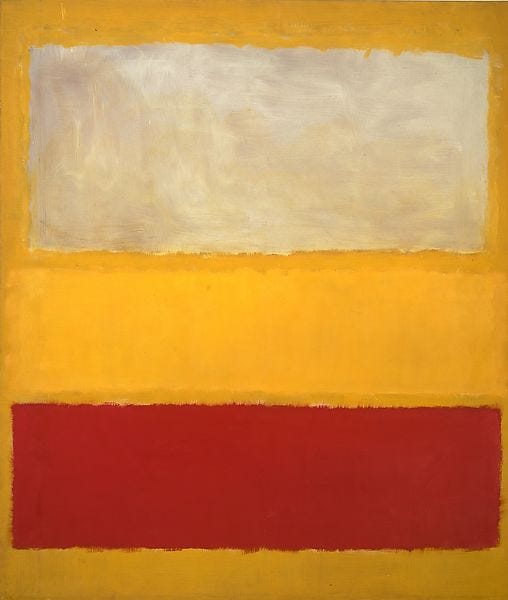~ What is a Painting? Each Painting is its own answer to this question. Any preconceived notion of what a painting is or ought to be stops us from Seeing the Painting before our eyes. The concepts that reveal a Painting’s intelligibility are those that are immanent to it—asked for by the work itself. We all too often see a painting without Seeing the Painting. ~

Mark Rothko’s No. 13 (White, Red on Yellow) is indifferent to the ordinary concepts of the viewer’s world, announcing itself to be a world of its own. It is large and fills the viewer’s field of vision, engulfing them like an environment. It is always changing since staring at saturated colors creates after-images of complementary hues that move as the viewer’s eyes move, thereby modulating the appearance of the physical pigment applied to the canvas. Like nature itself, it seems less to be something made by a human than something that simply is—its history unknowable since the process by which it was made obscures that very process. Once the viewer relinquishes their usual concepts—that is, leaves their ordinary world behind—and allows theirself to enter this new world that is the painting, they must let their perceptions teach them the concepts this world demands. Starting with all they have—what they can perceive—they begin to build new concepts. They see the shape of the canvas, the occasional glob of paint or brush bristle left behind, the relative effects of color. In looking, they realize that these perceptions occasioned by the painting are themselves mimicked in the painting: the shape of the large canvas is represented by smaller rectangles within; the physiological effect of the viewer’s eye layering after-images of color over the painting is reproduced by the material layering of paint on the canvas; the physical qualities of the materials, such as shadows cast by globs of paint, are reproduced in paint, as by a dark dot on its surface. By representing in paint the perceptions its own paint occasions in the viewer, the painting shows the viewer the concepts appropriate to its world: concepts of, what we might call, ‘rectangle,’ ‘layering,’ ‘paint glob’—concepts that grow out of the material nature of its medium. But we need not call them by these words. We could just as easily gesture or make up new words for our perceptions and the new concepts we abstract from them, because the painting presents what it represents and represents what it presents. To enter this world of paint, the viewer must become a child again and, through their sense of sight, begin to learn a new conceptual structure, language, and world.




I've been reading a collection of Donald Judd's reviews and he said this about Rothko, "The verticals are simultaneously areas, color, light, and volume—which is intrinsic to Rothko's successful work." That reading doesn't contradict anything you wrote but I think that this formal sophistication becomes the vehicle for that meaning. Rothko himself saw things in other terms and said stuff like, “I'm not an abstractionist. I'm not interested in the relationship of color or form or anything else. I'm interested only in expressing basic human emotions: tragedy, ecstasy, doom, and so on.” Anyway, I think that we need more close formal analysis of works of art but also more ecstasy and doom.
So interesting.... suspending our preconceived notions and looking with the eyes of a child- rewording, reimagining, remaking the world through the painting... a whole new of seeing art for me. Thanks for the nudge towrd something new...